Researchers have followed a female lineage from northern coastal China to the Americas using mitochondrial DNA. The team discovered evidence of at least two migrations by combining modern and ancient mitochondrial DNA: one during the last ice age and one during the melting period that followed.
Graphical abstract showing ice age migration routes from northern coastal China to the Americas and Japan. Credit: Li et al.
Another branch of the same lineage may have traveled to Japan about the same time as the second migration, which could account for the parallels in Paleolithic archaeological sites in the Americas, China, and Japan. The work is published online in Cell Reports on May 9 2023.
According to primary author Yu-Chun Li, a genetic anthropology at the Chinese Academy of Sciences, "The Asian ancestry of Native Americans is more complicated than previously indicated." We demonstrate that northern coastal China also contributed to the gene pool of Native Americans in addition to the previously mentioned ancestral sources in Siberia, Australo-Melanesia, and Southeast Asia.
Despite the long-held belief that Native Americans were descended from Siberians who traversed the transitory land bridge of the Bering Strait, more recent genetic, geological, and archaeological data points to the possibility of numerous waves of migration of humans to the Americas from other regions of Eurasia.
A team of researchers from the Chinese Academy of Sciences followed the path of a potential ancestral lineage that connects East Asian Paleolithic-age populations to founding populations in Chile, Peru, Bolivia, Brazil, Ecuador, Mexico, and California in order to shed light on the history of Native Americans in Asia. Mitochondrial DNA, which can be utilized to determine kinship through the female line, contains the questioned lineage.
After examining more than 100,000 modern and 15,000 ancient DNA samples from all around Eurasia, the researchers were able to pinpoint 216 modern and 39 ancient people who belonged to the uncommon ancestry. The researchers were able to determine the lineage's branching history by contrasting each of these individuals' accumulated mutations, geographic locations, and carbon-dated ages.
They were able to pinpoint two migration events from northern coastal China to the Americas, and they believe that in both instances the migrants arrived in America more likely via the Pacific coast than the inland ice-free route (which would not have been open at the time).
During the Last Glacial Maximum, when ice sheet covering was at its highest and conditions in northern China were probably unfavorable for humans, the first radiation event took place between 19,500 and 26,000 years ago. Between 19,000 to 11,500 years ago, during the ensuing deglaciation or melting era, the second radiation took place. At this time, there was a substantial rise in human numbers, perhaps brought on by the improving climate, which may have encouraged migration to new areas.
A surprising genetic connection between Native Americans and Japanese people was also found by the researchers. Another group split off from northern coastal China during the deglaciation and migrated to Japan. We were shocked to see that this ancestor also contributed to the gene pool in Japan, particularly the native Ainus, adds Li.
The Paleolithic populations of China, Japan, and the Americas have many archaeological features, which is explained by this discovery. The three areas were particularly similar in how they made stemmed projectile tips for spears and arrowheads. According to lead author Qing-Peng Kong, an evolutionary geneticist at the Chinese Academy of Sciences, "this suggests that the Pleistocene connection among the Americas, China, and Japan was not confined to culture but also to genetics."
Y chromosomal DNA provides complementary evidence that Native American male ancestors also existed in northern China at about the same period as these female ancestors, despite the study's focus on mitochondrial DNA.
Native American ancestry is now part of the picture, but there are still many unanswered questions. According to Kong, "the origins of several founder groups are still elusive or debatable." Next, in order to get a fuller picture of Native Americans' ancestry, we intend to gather and research more Eurasian lineages.







